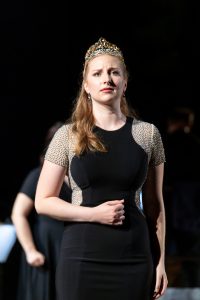
By Rosie Rogers
Although the exact circumstances of the composition of Henry Purcell’s Dido and Aeneas have been contested over the last 30 years, the first verifiable performance of the work was given in London by the students at Josias Priest’s School for Girls in 1689.
The lively cast of Palm Beach Opera’s 60th anniversary production of the opera on Dec. 11, made up of the company’s Benenson Young Artists and Apprentice Artists, were fitting successors to the youthful originators, creating an energetic start to the company’s new season.
Because portions of the original opera have been lost, production director Drew Minter, a countertenor and Baroque specialist, added other works by Purcell to fill out the work. The new material made up a short prologue, a song for Aeneas, and a final chorus. The orchestra and chorus were led by Gregory Ritchey, Palm Beach Opera’s associate conductor.
The location of the performance at the new Sculpture Garden at the Norton Museum of Art was an atmospheric backdrop perfect for the mythic origins of the story. The chorus was accompanied by crickets as well as by the orchestra. Beneath stars and leaning lemon trees, the performers seemed suspended in time, ready to meet gods and heroes.
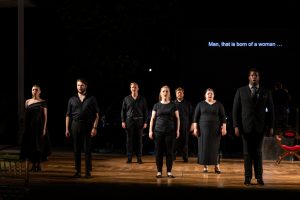
Opening with the solemn “Man that is born of a woman” from Purcell’s Funeral Music for Queen Mary set a foreboding tone, while the following “There’s not a swain on the plain,” an independent song of Purcell’s, immediately lightened it. This contrast in mood continued throughout the show, as Dido’s sincerity was juxtaposed with the witches’ mischievous gaiety.
The cast particularly shone when singing together as a chorus, their chemistry as an ensemble palpable. The group’s admirable flexibility of mood and color was best portrayed in the shift between playing Dido’s court to their especially comedic take on the villainous witches. Their exaggerated choreography combined with the cackles of Purcell’s music to create a group a little too gleeful and silly to feel threatening.
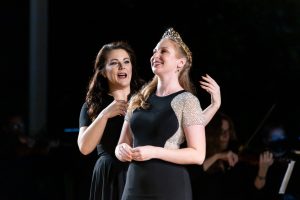
Avery Boettcher brought out a playful side of Belinda, particularly believable in her urgent matchmaking. Meridian Prall’s Sorceress sang confidently, particularly through her lower register, bringing out the sinister power of the role.
Megan Callahan’s graceful Dido was more outward than intimate. Instead of singing her famous ground-bass aria (popularly “Dido’s Lament”) to Belinda and the rest of her court, she turned and addressed the audience directly. Although I missed the closeness between Dido and Belinda sometimes present in the final aria, the final appeal to the audience emphasized Dido’s position as a public and beloved leader to Carthage, showing the great loss to her people beyond the personal tragedy of her love story.
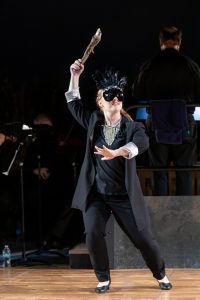
Bass-baritone Christopher Humbert Jr.’s soulful performance of Aeneas was particularly moving. Minter’s incorporation of the Purcell song “What shall I do?” granted Aeneas greater depth, giving a moment of contemplation to a character with no solo aria in the original work. This addition combined with Humbert’s excellent interpretation to create a conflicted hero dripping with pathos.
After the contrapuntal ending of the original work, Minter added “Suffer us not,” also from the Funeral Music for Queen Mary, as an epilogue. With this came another change in the return of Aeneas. While Aeneas usually sails away with no knowledge of Dido’s fate, in this production, he brings a rose to her funeral to grieve with her court. This ending is more conclusive, if a bit less Grecian.
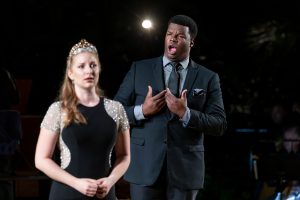
Bookended with explicitly Christian work from the Funeral Music, the tone of the opera became somewhat muddled. Although the execution of the epilogue was beautiful, ending the opera with an “Amen” felt a little out of place after a night full of references to Diana and Mercury.
Despite the additions from the Funeral Music for Queen Mary not quite blending with the spirit of the original work, the beautiful location and lively cast created a successful performance of a much-beloved opera. I look forward to the rest of Palm Beach Opera’s season, and especially to hearing more from their young artists.